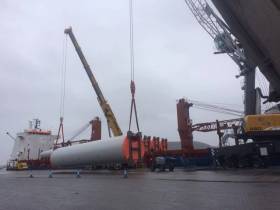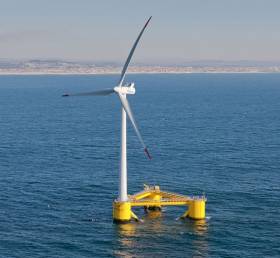Displaying items by tag: Wind Turbines
Join the conversation on Ireland’s offshore wind challenges at a public information meeting at the Fitzpatrick Castle Hotel in Killiney this Tuesday 12 March at 7.30pm.
Hosted in association with Dalkey Community Council and Killiney Bay Community Council, ‘Windfarms & Wildlife: Protecting the Bay’s Habitats — Uncover the Realities, Explore the Concerns’ will hear from guest speakers Dr Michael O'Meara of the Blue Horizon citizens group and chartered environmental scientist Marie Louise Heffernan.
A nationally recognised expert in the Habitats Directive, Marie Louise Heffernan specialises in biodiversity planning in the coastal zone, has expertise in marine breeding birds and her overall interest is balancing sustainable development with environmental protection. Her presentation for Tuesday is titled ‘From Terns to Turbines: Sustaining Dublin Bay's Rich Ecology’.
Dr Michael O'Meara has a longstanding appreciation of nature and the sea, and holds the record for kayaking solo around Ireland since 2015. He brings this passion for nature and his knowledge of the sea and coastal environment to the Blue Horizon campaign which calls for a 22km turbine-free zone off the Waterford coast in order to protect marine biodiversity, the local fishing economy, seascapes and tourism interests.
Admission to this information event is free but space is limited and only a few tickets remain. Reserve your spot via Eventbrite HERE.
Concerns about fast-tracking development of near-shore wind turbines have been expressed in several coastal communities, including Connemara and the Celtic Sea.
As The Irish Times Climate and Science Editor Kevin O’Sullivan reports, residents have expressed fears about the lack of marine protection and the visual impact of turbines planned for the Sceirde Rocks off north Galway Bay.
The project involving what may be up to 30 turbines is being developed by Fuinneamh Sceirde Teo, owned by Macquarie’s Green Investment Group.
It is one of the seven first-phase offshore wind projects – six in the Irish Sea and one in Galway Bay – granted marine area consents late last year.
A spokesman for the company says the wind farm will “contribute significantly to the future development of the local area, through job opportunities and economic development”.
Fisherman Kevin Conneely told O’Sullivan that five of the seven first-phase projects granted marine area consents are in areas he fishes.
Conneely took a legal case to ensure he continued to have the right to fish at Sceirdre Rocks, and the agreement cost him 25,000 euros.
He says that if all five projects succeed, he will be “out of business”.
Mick O'Meara of Blue Horizon is part of the Blue Horizon campaign group in the south-east calling for all offshore wind projects to be located at least 22km from the Waterford coast.
Read more in The Irish Times here
Scientists Say Offshore Wind Turbines in North Sea Could Have Significant Impact on Ecosystem
A team of German scientists has suggested that offshore wind farms in the North Sea could significantly impact the ecosystem.
The scientists from the Helmholtz-Zentrum Hereon Research Institute used numerical modelling to show how there could be physical disruptions to the marine environment, along with sedimentation and wind flow from turbines.
They forecast sedimentation could increase by as much as ten per cent as a result of transforming wind into electrical power.
Increased sedimentation could occur not only at the offshore wind farm clusters, but may also distribute over a wider region, the scientists say in a paper published in scientific journal, Communications Earth and Environment.
Their model also projects an increase in sediment carbon in deeper areas of the southern North Sea due to reduced current velocities, and decreased dissolved oxygen inside an area with already low oxygen concentration.
They say that their results “provide evidence that the ongoing offshore wind farm developments can have a substantial impact on the structuring of coastal marine ecosystems on basin scales”.
The paper explains that the North Sea is a shallow shelf sea system, in which “the interactions between bathymetry, tides and a strong freshwater supply at the continental coast foster a complex frontal system, which separates well-mixed coastal waters from seasonally stratified deeper areas”.
“The shallow coastal areas and sandbanks combined with stable wind resources make the North Sea an ideal area for renewable energy production and have made the North Sea a global hotspot for offshore wind energy production,” their paper states.
“ The recently negotiated European Green Deal to support the European target to phase out dependence on fossil fuels will further accelerate the development of offshore renewable energy, and a substantial increase of installed capacity (212 GW by 2050) is planned in the North Sea as a consequence to Europe´s strategy to be carbon neutral by 2050,” their paper points out.
They explain that underwater structures, such as foundations and piles, may cause turbulent current wakes, which impact circulation, stratification, mixing, and sediment resuspension
While increased sedimentation could see the North Sea adding more “blue carbon” to its seabed, and phytoplankton productivity may increase as a result of clearer waters in some areas, muddy grounds such as those inhabited by Nephrops or prawns would be negatively impacted.
The authors explain they cannot predict with accuracy which species will benefit and suffer as a result of wind farm developments offshore.
The full paper can be read here
Wind Energy Project Cargoes for Port of Waterford
#WindTurbines- A first batch of tower sections for a wind turbine project arrived at Port of Waterford last week on board an Antigua and Bermuda flagged cargoship, writes Jehan Ashmore.
The cargo was the first of nine tower sections of a four-turbine wind turbine project for GE Wind that were self-discharged from BBC Orion (2007/7,223grt). The ship operated by BBC Chartering having berthed at Beliew, the Port of Waterford's Terminal.
Following unloading of the inaugural batch, the wind turbines went into storage until the wind farm is ready to accept.
The instalment was handled by Celtic Shipping Agencies Ltd. The agency has also been nominated to handle a further two projects cargoes also for GE Wind through Waterford during 2017.
Of these, the first project is for a total of 28 turbine scheduled. As for the second project this is only to involve 10 turbines to be discharged.
The agency were also in recent years responsible for the Guinness fermentation tanks transported to Dun Laoghaire Harbour. From there the tanks were taken by road for an upgrading project at St. James's Gate Brewery in Dublin.
#PowerFromTheSea - The Irish Times reports that the Marine Institute hopes to install wind turbines in Galway Bay for an offshore renewable energy trial.
Permission is being sought for up to three turbines, with a maximum height of 35m above sea level, that would be installed at different times at the current ocean energy test site off Spiddal, along with a prototype offshore power generating station that would cover an area of 37 hectares.
The entire project will open for public consultation on Monday 18 April. The Irish Times has more on the story HERE.
This story was updated to correct the previously reported 60m height of the turbines, which, according to the Marine Institute, was based on a error in the lease application form. The Marine Institute also clarified that the turbines would not be installed concurrently.
Belfast Harbour Gets New Wind Turbine Building Hub
#BELFAST LOUGH NEWS - A new hub for wind turbine manufacturing at Belfast Harbour is expected to the completed by the end of this year, as the Belfast Telegraph reports.
The 50-acre reclaimed site on the shores of Belfast Lough chosen by Danish energy company DONG has apparently been kept vacant or more than 50 years awaiting the right development.
When operational early next year, the new 'offshore wind logistics terminal' - which will produce wind turblines for the West of Duddon Sands Wind Farm in the Irish Sea off Cumbria in north-west England - is expected to create 300 jobs in the growing renewable energy sector. Meanwhile, 150 workers will be needed for the construction phase.
A spokesperson for Belfast Harbour described the £50 million (€63.2 million) project as "the largest ever in Belfast Harbour's 400-year history" and "a major vote of confidence" in the harbour's long-term investment strategy.
The Belfast Telegraph has more on the story HERE.































































